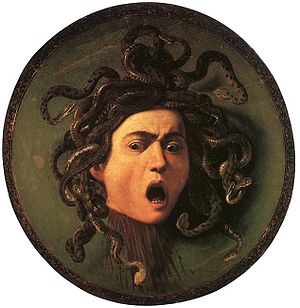
As soon as I saw Caravaggio’s image, “The Head of Medusa,” I knew that this was what I needed to do my blog on this week. I’ve always been a fan of Greek mythology and Medusa has always been one of my favorite characters from their lore. Caravaggio was commissioned, by Cardinal Francesco Maria Del Monte (the Medici family’s agent) in 1958 after he saw the artists first rendition in his home, to recreate his image on a shield in order to be a present for the Grand Duke of Tuscany. (Caravaggio.org)
The shield was meant to be a symbol of the Duke’s courageousness while facing enemies and to celebrate a recent victory. The Duke, being a part of the Medici family, saw the gorgon (Medusa) as a symbol they held close, seeing it as “an allegory of truth and wisdom.” (Uffizi)
Caravaggio really excels at using a darker theme in this image, and he uses the contrast between the light and dark to make Medusa look extremely realistic and practically three dimensional. Expanding upon that dark theme, Medusa has a look of horror on her face – this is supposed to be the moment that she realizes that her head and body are no longer connect, and worse, she still has her consciousness. (Totallyhistory.com)
As dark and macabre as this piece is, I think it is one of the few that I have seen during this class so far that I may actually own in my own home.
Works Cited
“Medusa by Caravaggio – Facts & History of the Painting.” Totally History Medusa Comments. N.p., n.d. Web. TotallyHistory.com.
“Medusa.” Medusa, 1597 by Caravaggio. N.p., n.d. Web. Caravaggio.org.
“Medusa.” Uffizi Gallery. N.p., n.d. Web. Uffizi.com.
This is an interesting choice. Its creepy and a little odd but powerful. I can see why Cardinal Francesco Maria Del Monte commissioned it for the Grand Duke of Tuscany to celebrate his courage and recent victory. It certainly gives the impression of someone who is intimidating and should be feared. The detail is phenomenal and I like it’s unusual circular shape. I can see why it piqued your interest!
LikeLike
I really like your choice for this blog. Honestly, Medusa is really cool to me, she is creepy but powerful and strong all at the same time. I love how the picture is really focusing on her face and the snakes, the color on her really shines while the snakes seem dark and mysterious.I personally wouldn’t want to own this piece of art, but it is a great piece and I can see why Cardinal Francesco Maria Del Monte wanted it and why you chose this for the post. It is a great piece of art.
LikeLike
Hi! Thanks for sharing! What a cool piece of art. For my blog post I also chose a piece by Caravaggio. However, it was a piece that displayed a Biblical scene. This artist certainly moved around! I think the most interesting fact about his art was his background! Caravaggio was a murderer, drunk, and violent man and you can see that perspective in art such as “Medusa,” but in pieces like “The Supper at Emmaus,” it is a totally different theme! He certainly never had his own theme, or design, like other great artist. But aspects of his art are used similarly in his work. Like the dark colors and starkness between the background and foreground. For more information on Caravaggio I attached a link you can check out!
https://www.caravaggio-foundation.org/biography.html
LikeLike
I originally thought that this piece was 3-dimensional, due to the skill in which the artist painted it. It is very dark, as you pointed out, but the colors are rich and deep, which contributes to its realism. It certainly is a powerful image, if not a little morbid, and I can see why the Duke took it to be a symbol of strength. Something I find interesting about art from this time (and times before) is how they portray facial expressions. Medusa’s mouth is open, presumably screaming from her beheading, yet her eyes and brows seem more neutral.
LikeLike
Hello! This is an incredible piece of artwork! I love the information you put in about the different tones, and about the history behind this artwork. I am really surprised that they considered it a allegory of wisdom and truth–I would had liked for you to go more in depth about that cause that is so interesting. I think that the colors and the value that the artist use really enhance the feeling that the art expels. This piece of artwork is definitely intriguing because it tells such a deep dark story of history just in itself, and I love that it is almost up for interpretation. Thanks for sharing!
LikeLike